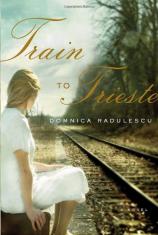Reading Group Guide
Discussion Questions
Train to Trieste

1. Mona falls in love with Mihai despite having learned that he “killed” his girlfriend, Mariana, in a mysterious hiking accident. “All I care about is that this man who is grieving for his dead lover turn his eyes on me . . . The smell of earth and death coursing through his heart makes me wild with desire” (p. 7). Does the association of Mihai with death resonate with Mona throughout the novel? How does the element of the unknown influence her feelings for him?
2. Mona’s mind often turns to family members whose life stories were even more desperate than her own --- and who managed to survive --- during the years of famine, wars, and Soviet rule in Romania: her grandmother Paraschiva floated down a river during a flood holding a mirror and a music box, surviving to marry the man who rescued her; her great-uncle Ivan disappeared during World War II, only to reappear twenty-five years later. What does Mona’s story share with these family stories “handed down and retold many times over the years, to the point where they have become vague and misty like fairy tales” (p. 21)? How is her particular story different?
3. Mona describes her birth as follows: “I was born in the morning to the smell of linden trees, to the sound of my mother’s sobs. I was born in the wild disorder of pain and mourning in my family, greedy for life and for my mother’s breast” (p. 23). What is the effect of the style of narration here? What moods and images do pages 22–29 present as Radulescu sets up the life story of the narrator?
4. What does it mean, for Mona, to be Romanian? What seem to be the special characteristics of her culture and its people? How does she differ in her attitude toward her country from both Mihai and her father?
5. Mona’s immigration to America is sponsored by evangelical Christians who seek to convert her to their way of thinking and want her to help them spread their faith (pp. 182–83). How is this ironic? Compare their way of practicing charity, and its effect on Mona, with that of in the people who help her in Trieste, in Italy (pp. 156–75).
6. Mona leaves her sponsors and gets a job at a convenience store; Marta, her co-worker from Mexico, becomes a loyal friend. Later, as she works on her doctorate, Mona teaches English as a second language to students from many other countries. How does living in Chicago shape how Mona’s feelings about becoming an American? As a novel of the immigrant experience, how does Train to Trieste compare with others you have read?
7. After a brief period of happiness, Mona’s marriage to Tom goes badly wrong: she has an affair with Janusz, a Serbian man, which only ends when she becomes pregnant with her first child. Later, after she and Tom have reconciled and she is pregnant again, she realizes that she must get a divorce (pp. 247–49). Why has Mona’s marriage become unbearable to her? Does her situation reflect the difficulties of cross-cultural relationships, or is it a simple matter of incompatibility? Does the ghost of Mihai have any affect on Mona’s subsequent relationships?
8. When necessary, Mona can be a creative tale-spinner: she tells her evangelical sponsors, Gladys and Ron, that she is Jewish and has become pregnant by the black post-man (p. 184), and she later tells the social worker who comes to observe her and her children that she made the packaged Alfredo sauce herself (p. 258). How does humor help Mona not only survive but thrive, first in Romania and then in America?
9. Mona’s sensibility, her way of describing experience, is extremely sensual. To what degree do these powerful aspects of her character tend to determine what happens in her life?
10. After emigrating, Mona spends many years without her parents. When her parents finally join her in Chicago, it seems that her father feels somewhat lost in America. What is it like for the family to be reunited? Does her father lose his identity and purpose, in a sense, by not having to fight the fascist regime at home, and by coming to America (pp. 217–18)? When Mona’s cousin Miruna comes to America, they make their first stop at the zoo (pp. 239-241). What does the sight of pink flamingos --- in winter --- signify for Mona and her family?
11. Mona is on State Street in Chicago when she sees a television in a shop window broadcasting the execution of Ceausescu and his wife. Remembering her own fantasy of killing him, Mona thinks, “How odd --- instead of the bone-deep satisfaction, the limitless joy, I always thought I’d be feeling when this moment came, all I feel is pity and disgust” (p. 231). Why is this moment so strange for Mona? Why is the relationship between dictators and their subjects so personal?
12. Mona is astonished and confused when she learns the truth about Mihai. Her visit to Mihai’s close friend Radu in Romania (pp. 283–301) gives her some closure, but it also brings up new questions about her history. How does Mona’s visit to Radu reorient her sense of the past, of Mihai, and even of her own father? Were you surprised by the conclusion --- and, what do you think happens next?
Train to Trieste
- Publication Date: August 5, 2008
- Hardcover: 320 pages
- Publisher: Knopf
- ISBN-10: 0307268233
- ISBN-13: 9780307268235







